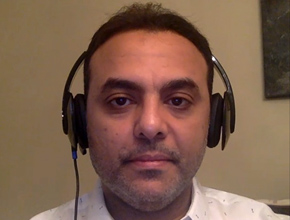Dr Waleed Alhazzani, associate professor in the Division of Critical Care at McMaster University, chair of Surviving Sepsis Campaign (SSC) guidelines, and lead author of the newest SSC guidelines focusing on COVID-19 in the critically ill, talks to Dr Roman Jaeschke about developing the first living guidelines to address the novel coronavirus epidemic.
References
Alhazzani W, Møller MH, Arabi YM, et al. Surviving Sepsis Campaign: guidelines on the management of critically ill adults with Coronavirus Disease 2019 (COVID-19). Intensive Care Med. 2020 Mar 28. doi: 10.1007/s00134-020-06022-5. [Epub ahead of print] PubMed PMID: 32222812; PubMed Central PMCID: PMC7101866.For part 2 of this interview, click here.
Roman Jaeschke, MD, MSc: Good evening. Welcome to another edition of McMaster Perspective. I have the pleasure of introducing Doctor Waleed Alhazzani, who was one of the chairs of the Surviving Sepsis Campaign practice guidelines and who is now a lead author and again one of the chairs of coronavirus disease 2019 (COVID-19) clinical practice guidelines.
Doctor Alhazzani, practice guidelines usually take 2 to 3 years to prepare. What’s happened here?
Waleed Alhazzani, MBBS, MSc: First of all, thank you for the invitation.
As you rightly mentioned, practice guidelines usually take on average 1 or 2 years to complete, especially when they’re addressing a large volume of questions and information. However, in this specific guideline, because of what’s happening around the world and the urgency for developing evidence-based guidance, we elected to do this procedure in a very short timeframe. There are several other groups doing what is known as “rapid guidelines” or “rapid recommendations,” and we used a similar approach in developing this guideline.
We started about 2 weeks ago. Specifically, the idea came up at the beginning of this month and we said, “We need to do this. Let’s move ahead.” We assembled a team. We included more than 30 panel members from 12 countries and from multiple disciplines. We have intensivists, methodologists who are also critical care physicians, and content experts in coronaviruses—whether severe acute respiratory syndrome coronavirus 2 (SARS-CoV-2) or the previous Middle East respiratory syndrome coronavirus (MERS-CoV) that happened a few years back. We also have microbiology and infectious disease doctors, virologists, infection control, specialists in public health, emergency physicians, and representatives from nursing.
Roman Jaeschke: Just to clarify: we are talking about practice guidelines in critical care–related areas of COVID-19, correct?
Waleed Alhazzani: Yes. I will come to these specifics of the guideline in a second.
The only part that we were missing on the panel was a patient representative, but given the very short timeline it was not feasible to get a patient representative on this guideline. Hopefully in the course of an ongoing update of this guideline we’ll try to get patient representatives to weigh in as well.
The focus of the guideline, as you mentioned, is on the management of the sickest patients with COVID-19, those who are admitted to the intensive care units (ICUs). We structured our guideline and questions to tackle different aspects of the management of these patients.
We divided the guideline into several sections. The first section deals with the safety of health-care workers, infection control: what are the measures and precautions that should be taken, and also testing recommendations, so which samples should be sent in those patients.
The next couple of sections deal with supportive care, so mainly ventilatory support and hemodynamic support. We address most of the issues that are related to ventilating those patients and also how to support their hemodynamics, how to resuscitate them if they develop shock in the ICU.
The last section focuses on therapy related to the disease itself, so things like adjunctive therapies, looking at corticosteroid use, other immunomodulating agents, temperature control in the ICU, but also direct antiviral and other interventions that have been tried or are being tried to treat this disease.
Roman Jaeschke: Fantastic. I hope we’ll talk about each of those areas very shortly and inform our listeners. I understand the guidelines will be published very soon.
Waleed Alhazzani: That’s correct. The guideline is under review and we expect it to be published in the next couple of days, hopefully. It will be available to the public, open access, and will not be behind a paywall, which is great. [A prepublication version of the guideline was shared on the website of the European Society of Intensive Care Medicine on March 20.]
Roman Jaeschke: This is incredibly fast. We’ll talk about the details within a couple of days.
It’s March 20. Today there was a lot of information about hydroxychloroquine (Plaquenil), the antimalarial drug. Without going into details, maybe you could tell us both what your group is saying now and, importantly, how you plan to handle incoming information.
Waleed Alhazzani: That’s a great question. In our guideline we tried to base our recommendations on the best available evidence. Sometimes that evidence is insufficient or inconclusive and does not allow us to issue a recommendation for or against an intervention. You’ll see this is a common theme in interventions related to direct antiviral activity or interventions that deal with treating SARS-CoV-2.
Having said that, yesterday or the day before [there was] a recent case series or an observational study that compared patients with COVID-19 in France who received hydroxychloroquine with those who did not receive hydroxychloroquine and historical controls from the literature. According to the authors, they found there was a reduction in the viral loads and resolution of symptoms was quicker than what is reported in the literature. So it is promising.
I think in order for us to make a recommendation we need at least a comparative study. It does not have to be a randomized controlled trial with very high quality to allow us to make a recommendation, especially now, when the disease is rapidly spreading. There’re many people affected. But balancing the benefits and the downsides of treatment, I think hydroxychloroquine is a cheap medication that’s available. It has some side effects but it’s relatively safe compared with other medications. Patients with dermatologic conditions take it for long periods of time, and it has been used as an antimalarial agent. So there is some merit to using this medication, but I think you can tell from what I’m saying what would be the message in our guideline, and this will take us to the next point about the longitudinal design of this guideline.
Given that there are many studies that are ongoing at the moment, addressing several interventions, it only makes sense to make this guideline a living guideline, which means that we will be continuously searching the literature, continuously summarizing the evidence as it comes up. When there’s evidence that is potentially practice-changing or that will warrant a change in the recommendations we made—either make them stronger or weaker, or change the direction—the panel will assemble quickly and issue an update to the recommendation. Or if there’s a new study that comes out suggesting that an intervention might be useful, not useful, or harmful, the panel will assemble as well, address it, and issue recommendations. We hope that our turnaround will be faster and that we’ll be able to update the recommendations within 48 hours from the release of those studies.
Roman Jaeschke: That’s a completely new reality of practice guidelines. We’ll finish our introduction to your guidelines today and then we’ll talk very soon about the details. Congratulations on this effort and let’s meet soon again. Thank you.
Waleed Alhazzani: Thank you for the invitation and looking forward to the next interview.
 English
English
 Español
Español
 українська
українська







